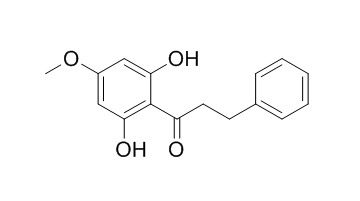2',6'-Dihydroxy 4'-methoxydihydrochalcone
2′,6′-Dihydroxy-4′-methoxydihydrochalcone exhibited potent antiplasmodial activity with IC50 values of12.69 μM against both chloroquine-sensitive and resistant strains of Plasmodium falciparum (F32, FcB1).
Inquire / Order:
manager@chemfaces.com
Technical Inquiries:
service@chemfaces.com
Tel:
+86-27-84237783
Fax:
+86-27-84254680
Address:
1 Building, No. 83, CheCheng Rd., Wuhan Economic and Technological Development Zone, Wuhan, Hubei 430056, PRC
Providing storage is as stated on the product vial and the vial is kept tightly sealed, the product can be stored for up to
24 months(2-8C).
Wherever possible, you should prepare and use solutions on the same day. However, if you need to make up stock solutions in advance, we recommend that you store the solution as aliquots in tightly sealed vials at -20C. Generally, these will be useable for up to two weeks. Before use, and prior to opening the vial we recommend that you allow your product to equilibrate to room temperature for at least 1 hour.
Need more advice on solubility, usage and handling? Please email to: service@chemfaces.com
The packaging of the product may have turned upside down during transportation, resulting in the natural compounds adhering to the neck or cap of the vial. take the vial out of its packaging and gently shake to let the compounds fall to the bottom of the vial. for liquid products, centrifuge at 200-500 RPM to gather the liquid at the bottom of the vial. try to avoid loss or contamination during handling.
Molecules.2016, 21(6)
Kor. J. Pharmacogn.2016, 47(1):62-72
Food Chem.2020, 327:126992.
Food Science and Biotechnology2022, 10.1007.
J. Mater. Life Sci.2024, 3:2:78-87
J Clin Transl Hepatol.2023, 11(4):863-876.
Appl Microbiol Biotechnol.2018, 102(12):5105-5120
TCI CO.2019, US20190151281A1
Microchemical Journal2014, 203:110804.
Molecules.2023, 28(8):3474.
Related and Featured Products
Phytochemistry, 2007, 68(9):1312-1320.
Activity-guided isolation of antiplasmodial dihydrochalcones and flavanones from Piper hostmannianum var. berbicense.[Reference:
WebLink]
METHODS AND RESULTS:
The bioassay-guided purification of an n-hexane extract from the leaves of Piper hostmannianum var. berbicense led to the isolation of four monoterpene or prenyl-substituted dihydrochalcones (1a, 1b, 2, 3) as well as the known compounds 2',6'-Dihydroxy 4'-methoxydihydrochalcone (4), linderatone (5), strobopinin (6), adunctin E (7) and (−)-methyllinderatin (8). Their structures were established on the basis of NMR and X-ray analysis.
CONCLUSIONS:
(−)-Methyllinderatin, linderatone and 2′,6′-dihydroxy-4′-methoxydihydrochalcone exhibited the most potent antiplasmodial activity with IC50 values of 5.64, 10.33 and 12.69 μM, respectively against both chloroquine-sensitive and resistant strains of Plasmodium falciparum (F32, FcB1). The activity of (−)-methyllinderatin was confirmed in vivo against Plasmodium vinckei petteri in mice (80% of reduction of parasitemia) at a dose of 20 mg/kg/day.
Food Science and Technology International, Tokyo, 1997, 3(3):285-289.
Antioxidative Constituents from the Aerial Part of Piper elongatum VAHL.[Reference:
WebLink]
METHODS AND RESULTS:
Six aromatic compounds, asebogenin (1), 2',6'-dihydroxy-4'-methoxydihydrochalcone (2), 3-geranyl-4-methoxy-benzoic acid (3), 3-geranyl-4-hydroxybenzoic acid (4), nervogenic acid (5) and 2,2-dimethyl-6-carboxyl-8-prenyl-chromene (6) were isolated from the methanol extract of the aerial part of Piper elongatum VAHL., whose leaves are used as a folk medicine in South America. The structures of 1-6 were elucidated by MS, 1H-NMR and 13C-NMR spectroscopies, and chemical evidence.
CONCLUSIONS:
Among these compounds, 1 showed stronger antioxidative activity than that of α-tocopherol, and 4 and 5 exhibited higher activity than that of t-butyl-4-hydroxyanisole (BHA) using the ferric thiocyanate method.
Química Nova,2007,30(5):1222-1224.
Antifungal derivatives from Piper mollicomum and P. lhotzkyanum (Piperaceae).[Reference:
WebLink]
METHODS AND RESULTS:
Bioguided fractionation of the extracts from leaves of Piper mollicomum and Piper lhotzkyanum against the fungi Cladosporium cladosporioides and C. sphaerospermum afforded seven bioactive compounds, four being chromenes: methyl 2,2-dimethyl-2H-chromene-6-carboxylate, methyl 8-hydroxy-2,2-dimethyl-2H-chromene-6-carboxylate, 2-methyl-2-[4'-methyl-3'-pentenyl]-2H-1-benzopyran-6-carboxylic acid, 2,2-dimethyl-2H-chromene-6-carboxylic acid, one a dihydrochalcone: 2',6'-dihydroxy-4'-methoxydihydrochalcone, and two flavanones: 7-methoxy-5,4'-dihydroxy-flavanone and 7,4'-dimethoxy-5-hydroxy-flavanone.
CONCLUSIONS:
The structures of the bioactive isolated derivatives were elucidated by interpretation of their NMR data [1H and 13C (BBD, DEPT 135º)], and mass spectral data as well as by comparison with data described in the literature.



